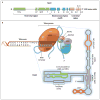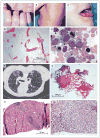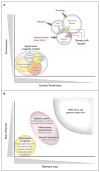Telomere diseases
- PMID: 20007561
- PMCID: PMC3401586
- DOI: 10.1056/NEJMra0903373
Telomere diseases
Conflict of interest statement
No potential conflict of interest relevant to this article was reported.
Figures





Comment in
-
Telomere diseases.N Engl J Med. 2010 Mar 25;362(12):1150. doi: 10.1056/NEJMc1000801. N Engl J Med. 2010. PMID: 20335598 No abstract available.
References
-
- Szostak JW, Blackburn EH. Cloning yeast telomeres on linear plasmid vectors. Cell. 1982;29:245–55. - PubMed
-
- Greider CW, Blackburn EH. Identification of a specific telomere terminal transferase activity in Tetrahymena extracts. Cell. 1985;43:405–13. - PubMed
-
- Heiss NS, Knight SW, Vulliamy TJ, et al. X-linked dyskeratosis congenita is caused by mutations in a highly conserved gene with putative nucleolar functions. Nat Genet. 1998;19:32–8. - PubMed
-
- Mitchell JR, Wood E, Collins K. A telo-merase component is defective in the human disease dyskeratosis congenita. Nature. 1999;402:551–5. - PubMed
-
- Olovnikov AM. Principle of marginotomy in template synthesis of polynucleotides. Dokl Akad Nauk SSSR. 1971;201:1496–9. (In Russian.) - PubMed
Publication types
MeSH terms
Substances
Grants and funding
LinkOut - more resources
Full Text Sources
Other Literature Sources
Medical
